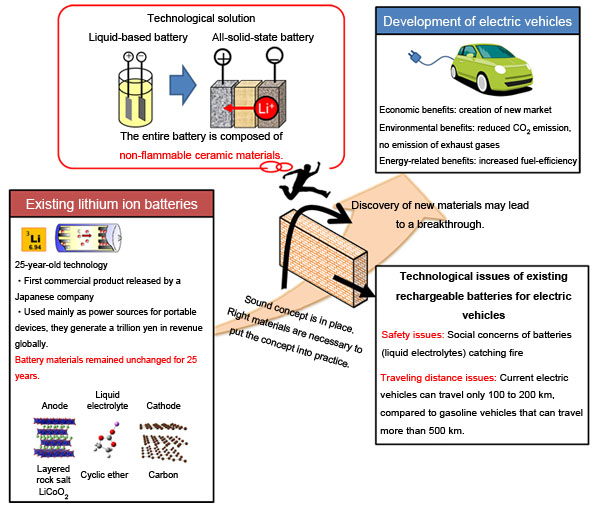Efficient Identification of Optimum All-Solid-State Battery Materials Using Data Science
2018.04.19
National Institute for Materials Science (NIMS)
Nagoya Institute of Technology
NIMS, Nagoya Institute of Technology and Toyota Motor Corporation jointly developed a system—a combined use of high-precision simulations of materials and data science techniques—capable of efficiently determining battery material compositions that conduct ions at the maximum rate. This system adequately determined optimum solid electrolyte materials for next-generation, all-solid-state lithium ion batteries by evaluating a large number of candidate solid electrolyte materials. The system was also effective in determining optimum sodium ion conductors by incorporating the information on optimum lithium ion conductors obtained earlier using machine learning algorithms.
Abstract
- NIMS, Nagoya Institute of Technology and Toyota Motor Corporation jointly developed a system—a combined use of high-precision simulations of materials and data science techniques—capable of efficiently determining battery material compositions that conduct ions at the maximum rate. This system adequately determined optimum solid electrolyte materials for next-generation, all-solid-state lithium ion batteries by evaluating a large number of candidate solid electrolyte materials. The system was also effective in determining optimum sodium ion conductors by incorporating the information on optimum lithium ion conductors obtained earlier using machine learning algorithms.
- Development of all-solid-state batteries, led mainly by battery and automobile manufacturers, has been making progress in recent years. All-solid-state batteries containing solid electrolytes composed of non-flammable ceramic materials are substantially safer than conventional lithium ion batteries containing flammable organic electrolytes. In addition, because energy densities of all-solid-state batteries may be increased by condensing these batteries, they are promising next-generation rechargeable batteries. It is difficult, however, to identify ceramic materials with a high ionic conductivity suitable as solid electrolytes by exploring a vast number of candidate materials using a trial-and-error approach. As such, there is strong demand for the development of more efficient materials exploration methods.
- In this research project, we constructed a database on lithium ion conductivity in solid materials by performing high-precision simulations of materials and analyzed the simulation results by combining two data science techniques: Bayesian optimization and machine learning. We confirmed that this procedure efficiently identified battery materials with desirable properties. More specifically, we assessed 318 tavorite-structured materials with different chemical compositions for their lithium and sodium ion conductivity using the procedure above. The searching speed of this procedure was about two to three times faster than that of the conventional trial-and-error approach.
- The conventional objective of materials simulations is to perform detailed analysis on ionic conduction mechanisms in existing materials. Our results indicated that such simulations, when combined with data science technology, may also be useful in identifying materials with desirable functions. Because the search efficiency of the system we developed is expected to increase with increased input data size, the system may offer an effective material exploration technique capable of dealing with a vast number of target materials.
- This project was carried by a joint research team consisting of Randy Jalem (Researcher, NIMS), Nakayama Masanobu (Professor, Nagoya Institute of Technology; also affiliated with CMI2, NIMS), Ichiro Takeuchi (Professor, Nagoya Institute of Technology), Kenta Kanamori (Doctoral Student, Nagoya Institute of Technology), Dr. Hisatsugu Yamasaki (Toyota Motor Corporation) and Dr. Toshiya Saito (Toyota Motor Corporation).
This research was supported by the "Materials Research by Information Integration" Initiative sponsored by the JST’s Support Program for Starting Up Innovation Hub. - This study was published in the online journal Scientific Reports at 10:00 am on April 11, 2018, GMT (6:00 pm on April 11, Japan Time).

Figure. Development of all-solid-state batteries and their contribution to electric vehicles
Related files
- Center for Green Research on Energy and Environmental Materials
Contacts
(Regarding this research)
-
JALEM Randy,
Researcher,
Interface Computational Science Group,
Center for Green Research on Energy and Environmental Materials,
National Institute for Materials Science
TEL: +81-29-851-3354
E-Mail: JALEM.Randy=nims.go.jp
(Please change "=" to "@")
(For general inquiries)
-
Public Relations Office
National Institute for Materials Sciences
Tel: +81-29-859-2026
Fax: +81-29-859-2017
E-Mail: pressrelease=ml.nims.go.jp
(Please change "=" to "@")
Same Keywords
-
Success in Efficient Fabrication of High-Performance Neodymium Magnets Using Machine Learning
(machine learning,Bayesian optimization)
2021.11.15
-
Significant Increase in Power Output of Thermoelectric Materials Using Machine Learning
(machine learning,Bayesian optimization)
2019.03.19
-
High-Precision Analysis of Microstructures in 2D Materials Using Electron Microscopy and Machine Learning
(machine learning)
2025.08.25
